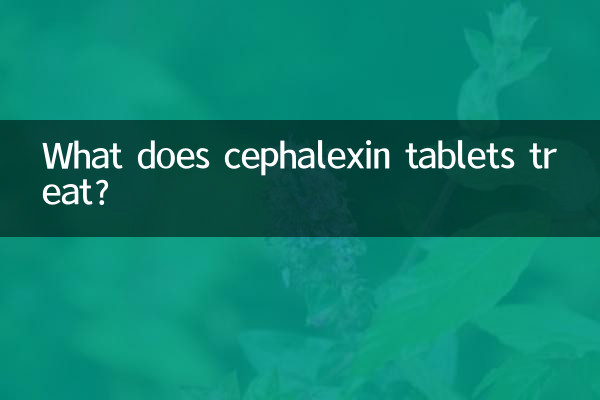What does cephalexin tablets treat?
Recently, with the arrival of the flu season and the increase in respiratory infection cases, the discussion about the use of antibiotics has become one of the hot topics. Among them, cephalexin tablets, as a commonly used antibiotic, have attracted much attention. This article will analyze the uses, indications, contraindications and precautions of cephalexin tablets in detail, and attach structured data to help readers quickly understand this drug.
1. Basic information about Cephalexin Tablets

Cephalexin tablets belong to the first-generation cephalosporin antibiotics and have broad-spectrum antibacterial effects. It achieves bactericidal effects by inhibiting bacterial cell wall synthesis. The following is basic information about Cephalexin Tablets:
| Drug name | Cephalexin tablets |
|---|---|
| English name | Cefalexin Tablets |
| drug class | Antibiotics (first generation cephalosporins) |
| Main ingredients | Cephalexin |
| Dosage form | Tablets, capsules |
2. Indications of Cephalexin Tablets
Cephalexin tablets are mainly used to treat infectious diseases caused by sensitive bacteria. The following are its common indications:
| Indications | specific disease |
|---|---|
| respiratory tract infection | Acute tonsillitis, pharyngitis, bronchitis, pneumonia, etc. |
| urinary tract infection | Cystitis, pyelonephritis, etc. |
| Skin and soft tissue infections | Boils, carbuncles, cellulitis, etc. |
| other infections | Otitis media, sinusitis, etc. |
3. Contraindications and precautions of Cephalexin Tablets
Although cephalexin tablets are a relatively safe antibiotic, there are still some contraindications and precautions you need to know:
| Contraindications | Things to note |
|---|---|
| Contraindicated for those allergic to cephalosporin antibiotics | Ask about allergy history before taking medication |
| Use with caution in patients with severe renal insufficiency | Need to adjust dosage or extend dosing interval |
| Use with caution by pregnant and lactating women | Use after weighing the pros and cons |
4. Usage and dosage of Cephalexin Tablets
The usage and dosage of cephalexin tablets need to be adjusted according to the patient's age, weight and degree of infection. The following are common usage dosages:
| crowd | Usage and dosage |
|---|---|
| adult | 250-500mg each time, 3-4 times a day |
| children | 25-50mg/kg daily, divided into 3-4 times |
| People with renal insufficiency | Dosage needs to be adjusted based on creatinine clearance |
5. Side effects of Cephalexin Tablets
Cephalexin tablets may cause some side effects, common ones include:
| Side effect type | Specific performance |
|---|---|
| gastrointestinal reactions | Nausea, vomiting, diarrhea, etc. |
| allergic reaction | Rash, itching, and possible anaphylactic shock in severe cases |
| Others | Dizziness, headache, abnormal liver function, etc. |
6. Recent hot discussions about Cephalexin Tablets
In the past 10 days, discussions about cephalexin tablets on social media and health forums have mainly focused on the following aspects:
1.Antibiotic abuse problem: Many netizens called for careful use of antibiotics such as cephalexin tablets to avoid the increase in drug resistance.
2.The difference between influenza and bacterial infection: Experts remind that cephalexin tablets are only effective against bacterial infections and not against viral infections. A clear diagnosis is required before use.
3.Home medicine cabinet stocking: Some families use cephalexin tablets as a standing drug, but doctors recommend using it under professional guidance.
7. Summary
Cephalexin tablets are an effective antibiotic for a variety of bacterial infections. However, you must strictly follow medical advice when using it to avoid abuse. The recent discussion on the rational use of antibiotics also reminds us that scientific medication is the key to protecting health.

check the details

check the details